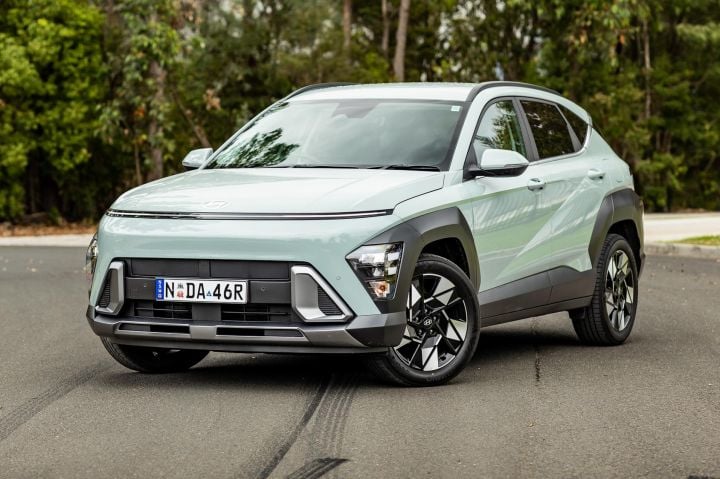

Matt Campbell
2026 Hyundai Kona review
Pros
- Lovely to drive
- Cool hybrid system with interactive elements
- Strong spec inclusions
Cons
- Could be even cheaper
- Annoying safety chime tech
- Four-star ANCAP rating
23 Days Ago
The latest-generation 2025 Hyundai Kona, which was introduced in mid-2024, sees minimal updates for the 2025 lineup. The entry price has increased by $500, including models with the optional N Line package, while Premium variants and their N Line equivalents remain unchanged.
Two additional minor updates have been made: base Kona variants now feature leather-appointed armrests on the doors, and hybrid variants have received updated rear badging.
The range continues to offer three internal combustion powertrains, including a hybrid option. Models equipped with the turbocharged engine can be equipped with an all-wheel drive configuration. Changes for the MY25 Kona Electric have yet to be confirmed.
Retail Price
Transmission
6-speed Auto (DCT), Auto (CVT), or Single-Speed Auto
Driven Wheels
Front
Fuel Type
Electric or Unleaded
Body Types
SUV
Powertrain Type
Combustion, Electric, or Hybrid
View 7 images
Retail Price
Transmission
6-speed Auto (DCT), Auto (CVT), or Single-Speed Auto
Driven Wheels
Front
Fuel Type
Electric or Unleaded
Body Types
SUV
Powertrain Type
Combustion, Electric, or Hybrid
Good
6 Reviews
CarExpert does the hard work to get you the best price. No negotiating, no hidden costs, just expert help and real savings on your next new car.
Engine specs, power, and efficiency
Drive Feel: Steering, Suspension, Ride Quality
Strength, stability, and off-road performance
Design, size, and presence on the road
Comfort, tech, and convenience inside
Infotainment, connectivity, and smart features
Protection, prevention, and alerts
Coverage, maintenance, and peace of mind
The Hyundai Kona comes in a variety of variants with the cheapest being Base and the most expensive being Premium N Line.


Matt Campbell
23 Days Ago
Quickly see how the Hyundai Kona stacks up against its competition.
Select any benchmark to see more details.
Where expert car reviews meet expert car buying – CarExpert gives you trusted advice, personalised service and real savings on your next new car.
| Specification | Measurement |
|---|---|
| Overall Length | 4,350 mm |
| Overall Width | 1,825 mm |
| Overall Height | 1,585 mm |
| Wheelbase | 2,660 mm |
| Turning Circle | 10,600 mm |
| Load Capacity | 430 mm |
Dimensions in this table show the minimum and maximum values of all variants for this vehicle.
Our Hyundai Kona Exterior and Dimensions Page has every measurement you need to know exactly how this vehicle will fit your driving, garage, or work needs.





Hyundai Kona


William Stopford
5 Months Ago


Josh Nevett
10 Months Ago


Josh Nevett
11 Months Ago
Where expert car reviews meet expert car buying – CarExpert gives you trusted advice, personalised service and real savings on your next new car.
Hyundai Kona
The cheapest Hyundai Kona is the Base that starts from $32,700.
See all Hyundai Kona PricingThe most expensive Hyundai Kona is the Premium that starts from $68,000.
See all Hyundai Kona PricingThe best towing capacity of a Hyundai Kona is 1300 kg offered by the following variants: Base, Elite, Elite N Line, Premium and Premium N Line.
See all Hyundai Kona towing capacityThe largest Hyundai Kona is the Elite N Line which measures 1825mm wide, 4385mm in length and sits 1590mm tall.
The most powerful Hyundai Kona is the Base which has 150kW of power from its null engine.
The Hyundai Kona is built in Korea and shipped to Australia.
The heaviest Hyundai Kona is the Base which weighs 2220 kg (kerb weight).
The Hyundai Kona may use different fuel/energy types based on the variant which includes Electric or Unleaded.
# Based on VFACTS and EVC data
* Average savings based on recent CarExpert customer transactions. Actual savings will vary depending on vehicle make and model, location, stock availability, and other factors.
† Displayed prices exclude on-road costs such as delivery charges, registration fees, number plates, insurance and applicable road taxes. These prices are subject to change without notice and may not reflect current market pricing or dealer offers.
 Automotive Vehicle Spec Data & 4K images Powered by JATO Dynamics Ltd
Automotive Vehicle Spec Data & 4K images Powered by JATO Dynamics Ltd